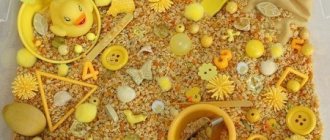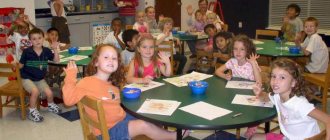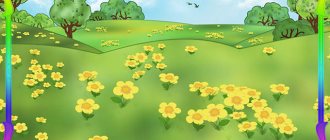On the topic: methodological developments, presentations and notes
Summary of a lesson on familiarization with the outside world and drawing in the second junior, middle group Summary of a lesson on familiarization with the outside world and drawing in the second junior, middle group
Drawing with paints. (fingers)…
Notes for a comprehensive lesson in mathematics and design in the second junior group Notes for a comprehensive lesson in mathematics and design in the second junior group Notes for classes
Introduce children to number and figure 6. Improve counting skills and comparison of subject aggregates. Form children’s ability to distinguish between the concepts of yesterday, today, tomorrow. Consolidate knowledge about geome...
Open lesson in the second junior group: “Chissed spoon - gilded handle”, deepening into the topic “Utensils” in the second junior group
Open lesson “Chissed spoon - gilded handle”, deepening into the topic “Utensils” in the second junior group No. 10 of kindergarten No. 115. Goal and objectives: 1. Teaching children to decorate...
Long-term plan for experimental and experimental activities of children of the second younger group. Long-term plan for cognitive development in the second junior group. Family plan
Long-term plan for experimental and experimental activities of children of the second junior group. Topic Contents Goal Form of organization Water/Exercises: “Let's wash our hands”, “Wash the doll”, “Boats are sailing”, “P...
Card index of physical education minutes in the second junior group; Card file of gymnastics after sleep in the second younger group; Card index of outdoor games in the second junior group; Card index of morning exercises in the second junior group.
Card index of physical education minutes in the second junior group; Card file of gymnastics after sleep in the second younger group; Card index of outdoor games in the second junior group; Card index of morning exercises...
Analytical report of monitoring results in the second junior group of “Kapitoshki” in the 2016-2017 academic year. The educational process in the second junior group is built on the basis of the educational program of preschool education “From Birth”
Analytical report of the monitoring results in the second junior group “Kapitoshki” in the 2016-2017 academic year. The educational process in the second junior group is…
Goal: To develop creative imagination in children, improve means of expressiveness in conveying images, enrich and activate speech through theatrical activities. Objectives: ·…
Goals:
Expand children's knowledge about clothing. Enrich children's vocabulary on the topic. Teach children to classify clothes according to a given criterion (winter or summer, women's or men's). Introduce the profession of a seamstress and some of the tools she uses for her work. Reinforce the concepts of color, size, shape, quantity. Introduce the musical work “Polka” by S. Rachmaninov. Continue teaching children to finger paint, sculpt and stick. Develop thinking, attention, fine and gross motor skills. Develop differentiation of auditory and visual perception.
Equipment:
Pictures depicting various clothes. Dolls in various clothes, box. Stencils of various clothes, cut out of white cardboard, pieces of fabric of similar size. Cut-out pictures of clothes. Demonstration picture of a “seamstress”, toy sewing machine, needle, scissors. Cut-out pictures depicting a boy and a girl, various clothes, rectangles in pink and blue colors. Multi-colored clothespins, silhouette images of dresses made of cardboard in yellow, green, red and blue. Pictures depicting clothes of different colors, with “holes” in the form of geometric shapes; similar geometric shapes. Pictures “What did the artist mix up?” Pictures “Find the extra object.” Drawing-coloring of various types of clothing, finger paints, wet wipes. Pencils. Pictures for shading with images of clothing. Ribbons of different lengths. Silhouettes of clothes cut out of colored non-glossy cardboard, pockets cut out of paper, glue sticks, plasticine, buttons. Various equipment for dynamic breaks: benches, tunnel, arcs, paths, stumps, etc. Audio recording: “Polka” by S. Rachmaninov, music for a dynamic pause.
Progress of the lesson:
Greeting "Everyone clapped their hands"
Everyone clapped their hands, together, more fun! Our feet started pounding, louder and faster! We'll hit you on the knees. Hush, hush, hush. We raise our hands, our hands, higher, higher, higher! Our hands began to spin. They went down again. They circled, circled and stopped.
Surprise moment “The dolls are coming”
Tryndi-bryndi, balalaikas, dolls are riding in a taratayka. Hey guys, don't yawn, choose your own doll!
The teacher takes out a box of dolls, the children choose one doll for themselves.
Didactic exercise “Name the clothes and their parts”
The teacher draws the children’s attention to the doll’s clothes, similar clothes to the children, and asks them to name the details (collar, pocket, hood, buttons, etc.)
Didactic game “Pick up a patch”
You need to choose a patch piece of a suitable shape and color to sew up holes in your clothes.
Visual activity “Clothes with pockets and buttons”
You can choose your own clothes that you will now decorate.
Children choose colored silhouettes of coats, overalls, raincoats and stick pockets on them. Then small balls are molded from plasticine, pressed onto the clothes, and buttons are placed and pressed on top.
Didactic exercise “Find half of the clothes”
Here you guys have halves of different clothes, find other halves for them, so that two halves make a whole.
After the child completes the task, the teacher asks him what kind of clothes he got.
Listening to the music “Polka” by S. Rachmaninoff
Children listen to the first part of the musical composition, and while listening to the second part they play along with musical hammers.
Game with clothespins "Dress"
Let's use clothespins to make the dress long sleeves and frills at the bottom. You can choose clothespins of the same color as the dress, you can alternate them, or you can make them multi-colored. As the children work, the teacher asks them what color clothespins they used.
Didactic game “Clothes for boys and girls”
The mother washed the clothes of her son and daughter and asked them to neatly put their clothes in the closets. Show your son, daughter. The girl has a pink wardrobe, like this, and the boy has a blue wardrobe, like this. Help the children organize their clothes correctly in their closets.
Didactic exercise “Find the extra object”
In the picture you see different clothes, but one item is not clothes. Cover this excess item with your palm. What did you cover? Why? A teapot (ball) is not clothing.
The sheet is cut into two parts horizontally and distributed to the children.
Didactic game “What did the artist mix up?”
Look at the picture. What did the artist get wrong? What clothes do people wear in warm weather? What clothes do you wear in winter when it's cold?
Dynamic pause “Journey”
Children move around the perimeter of the room to the music, overcoming various obstacles.
Didactic exercise “Long-short ribbons”
There are ribbons in front of you. Let's count them. How many tapes? Three ribbons. You can say. Are these tapes the same? No, these tapes are different. They have different colors and lengths. Show the longest ribbon. What color is it? Show me the shortest feed? What color is it? Which tape didn't you show?
Looking at the painting “The Seamstress”
Today we saw a lot of different clothes, but who makes them? Do you know who sews clothes? Look, this picture shows a seamstress - that’s what they call a person who sews. This seamstress is sewing a skirt. Another seamstress made my dress. Other seamstresses have made your clothes. What tools does a seamstress use? Needle, scissors, sewing machine.
Exercise “Choose fabric for clothes”
You already know what kinds of clothes there are, who sews them, what clothes are made with. What are clothes made from? Clothes are made from fabric. Here in front of you are pieces of various fabrics. Spread them evenly in front of you and place a stencil on top. What happened? Try changing the fabric. Now change the stencil. Show me the fabric stencil that you think is the most beautiful.
Finger gymnastics “Washing”
I will wash it cleanly (movements with fists, imitation of washing)
Shirt, jacket and T-shirt, (Alternately rubbing all fingers)
Sweater and trousers - My arms are tired. (Shaking hands)
Exercise "Hatching"
Take pencils and draw stripes on the clothes.
Finger painting “Color the clothes”
Children are invited to choose their own clothing model and color it using finger paints.
Lesson in the younger group
"My clothes"
1. Form children’s ideas about their clothes
2. Develop the ability to notice problems in clothing
3. Cultivate neatness and neatness in children
4. Create the need to undress and dress yourself
Children's educational games, lessons, crafts
We study clothes. Lesson 1Educational activities for kids The first thematic lesson is Clothes. Classes are designed for children aged 2-3 years. What kind of clothes are there, what they are needed for, who designs them and where they get them. We suggest devoting several days to this topic to understand and consolidate the information. |
CardsYou can buy such cards in a ready-made set, or you can make them yourself. The format for the cards is at your discretion, but it should not be very small. Each card contains one item. At the bottom of each card is a signature, preferably in red and block letters. Pictures can be cut out from magazines, gradually collecting the required number. |
Clothing: blouse, skirt, dress, shirt, tracksuit, apron, trousers, suit, jacket, tie, jacket, jeans, sundress, sandals, shoes, slippers, sweater, hat, handkerchief, pajamas, T-shirt, sneakers, coat, raincoat, socks, scarf, shorts, gloves, mittens. Children's clothing: booties, rompers, bib, vest, cap. Headwear: hat, baseball cap, Panama hat, scarf.
Game “Dress up the paper doll”Dress up a paper doll. Either a purchased kit or a homemade one. For small children, you can not attach clothes to the doll, but simply put them on top. The tasks can be different: The doll goes for a walk outside in winter - outerwear, the doll cooks - an apron, sleeps - pajamas, etc. At the same time, we tell you that each occasion has its own clothes, and we laugh together when mom (as if by accident) dresses the doll for the holiday in pajamas and a robe. Don’t think that these games are only for girls; boys also need to understand clothes. You can download and print the paper doll that you see in the picture on the left using the link below. Download: Dress up a paper doll >>> |
Let's play store
In this game you can use both cards and ordinary clothes pulled out of the wardrobe. But with cards, it will still be more convenient. Lay out the pictures on the table or floor, decide which of you will be the seller - the consultant. First, it’s better for mom to take on the role of a consultant. A buyer comes to the store and asks for help choosing a dress for a matinee or clothes for the street, and the consultant recommends his product from the store and offers to buy the right one. You can immediately buy in bulk, as if you need children’s clothing in bulk for the senior group of a kindergarten, and at the same time explain what wholesale sales are.
We come up with a pattern for the dress.
Cut out the silhouette of a dress from a white landscape sheet. Let the child make this ugly white dress a festive one, in which she herself would like to dress up. (Sketch). In this game we explain who fashion designers are and what they do. In the game you can draw on the dress, make appliques, stick pieces of plasticine. We study: pockets, collar, belt, button fasteners, lace….




